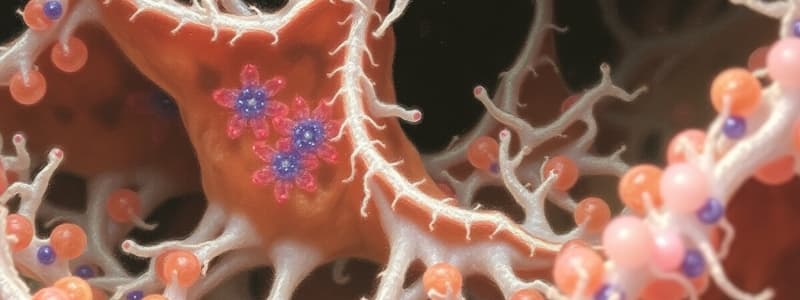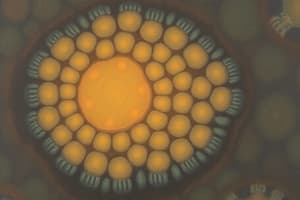Podcast
Questions and Answers
Which cellular component is responsible for generating ATP through the process of cellular respiration?
Which cellular component is responsible for generating ATP through the process of cellular respiration?
- Golgi apparatus
- Chloroplasts
- Mitochondria (correct)
- Endoplasmic reticulum
In plant cells, what is the primary function of chloroplasts?
In plant cells, what is the primary function of chloroplasts?
- Storing genetic information
- Converting light energy into glucose (correct)
- Synthesizing proteins
- Generating ATP
Which of the following best describes the process of DNA replication?
Which of the following best describes the process of DNA replication?
- Creation of an exact copy of a DNA molecule (correct)
- Synthesis of proteins from RNA
- Conversion of RNA into DNA
- Breakdown of complex molecules into simpler ones
What role do nucleic acids play in a cell's function?
What role do nucleic acids play in a cell's function?
Which of the following features is characteristic of plant cells but not typically found in animal cells?
Which of the following features is characteristic of plant cells but not typically found in animal cells?
Which of these BEST describes the concept of adaptation in evolutionary biology?
Which of these BEST describes the concept of adaptation in evolutionary biology?
In the Linnaean system of classification, which level would directly precede the Family category?
In the Linnaean system of classification, which level would directly precede the Family category?
What is the primary role of ATP in cellular processes?
What is the primary role of ATP in cellular processes?
Which of the following BEST describes the process of transcription in protein synthesis?
Which of the following BEST describes the process of transcription in protein synthesis?
What is the primary function of DNA polymerase enzymes during DNA replication?
What is the primary function of DNA polymerase enzymes during DNA replication?
Flashcards
Photosynthesis
Photosynthesis
The process by which plants and other organisms use light energy to convert carbon dioxide and water into glucose and oxygen, releasing oxygen as a byproduct.
Cells
Cells
The basic units of life, characterized by a complex internal structure and various functions. These are the smallest unit of life that can exist independently.
Cellular Respiration
Cellular Respiration
The process of breaking down glucose to release energy in the form of ATP, which is the energy currency of the cell.
Organelle
Organelle
Signup and view all the flashcards
Mitosis
Mitosis
Signup and view all the flashcards
Evolution
Evolution
Signup and view all the flashcards
Homeostasis
Homeostasis
Signup and view all the flashcards
DNA replication
DNA replication
Signup and view all the flashcards
Study Notes
Cell Structure and Function
- Cells are the basic units of life, exhibiting a complex internal structure and functions.
- Prokaryotic cells (bacteria and archaea) lack a nucleus and membrane-bound organelles; eukaryotic cells (plants, animals, fungi, protists) possess a nucleus and organelles.
- Major cellular components include the cell membrane, cytoplasm, nucleus, mitochondria, ribosomes, endoplasmic reticulum, Golgi apparatus, lysosomes, vacuoles, and chloroplasts (in plant cells).
Cellular Processes
- Cellular respiration breaks down glucose to release energy as ATP.
- Photosynthesis uses light energy to convert carbon dioxide and water into glucose and oxygen.
- DNA replication creates an exact copy of a DNA molecule.
- Protein synthesis involves transcription (DNA to RNA) and translation (RNA to protein).
- Cell division (mitosis and meiosis) is vital for growth, repair, and reproduction.
Biological Molecules
- Carbohydrates (carbon, hydrogen, oxygen) are a primary energy source.
- Lipids (fats and oils) are cell membrane components and energy storage molecules.
- Proteins are complex molecules crucial for cellular functions (structure, catalysis, transport).
- Nucleic acids (DNA and RNA) store and transmit genetic information.
Plant vs. Animal Cells
- Plant cells have a cell wall, chloroplasts, and a large central vacuole; animal cells lack these.
- Plant cells store energy as starch; animal cells store energy as glycogen.
- Plant cell shape is fixed due to the cell wall; animal cells are flexible.
Genetics
- Genes are DNA segments that code for specific proteins.
- DNA carries the genetic code, determining organism traits.
- Heredity transmits genetic information between generations.
- Chromosomes are DNA and protein structures carrying genes.
- Mutations are DNA sequence changes, potentially altering traits.
Ecology
- Ecology studies organism-environment interactions.
- Ecosystems include biotic (living) and abiotic (non-living) factors.
- Biodiversity is the variety of life, encompassing genetic, species, and ecosystem diversity.
- Food chains and webs describe energy transfer.
- Population dynamics analyze population growth and size.
- Competition and predation influence community interactions.
Evolution
- Evolution is the change in heritable characteristics over generations.
- Natural selection favors traits suited to an environment.
- Adaptation improves survival and reproduction.
- Common ancestry suggests all organisms share a common ancestor.
Classification
- Organisms are grouped hierarchically by shared characteristics and evolutionary relationships.
- Taxonomy classifies and names organisms.
- The Linnaean system uses a hierarchy (Kingdom, Phylum, Class, Order, Family, Genus, Species).
Homeostasis
- Homeostasis maintains a stable internal environment.
- Temperature, water balance, pH, and other factors are crucial for cellular function and survival.
- Feedback mechanisms (positive and negative) regulate internal conditions.
Cellular Respiration & Photosynthesis Details
- Cellular Respiration occurs in stages (glycolysis, Krebs cycle, electron transport chain) producing ATP.
- Photosynthesis involves light-dependent and light-independent stages, capturing light energy to produce glucose from carbon dioxide and water.
DNA Replication
- DNA replication involves unwinding the double helix, separating strands, and synthesizing complementary strands using DNA polymerase.
Protein Synthesis
- Transcription converts DNA's genetic code to mRNA.
- Translation uses the mRNA code to synthesize proteins using ribosomes and tRNA.
- Different RNA types have specific roles in this process.
Studying That Suits You
Use AI to generate personalized quizzes and flashcards to suit your learning preferences.



